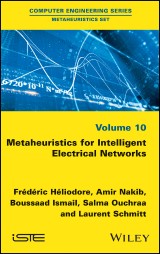Details
Metaheuristics for Intelligent Electrical Networks
1. Aufl.
|
139,99 € |
|
| Verlag: | Wiley |
| Format: | EPUB |
| Veröffentl.: | 07.08.2017 |
| ISBN/EAN: | 9781119136750 |
| Sprache: | englisch |
| Anzahl Seiten: | 288 |
DRM-geschütztes eBook, Sie benötigen z.B. Adobe Digital Editions und eine Adobe ID zum Lesen.
Beschreibungen
<p>Intelligence is defined by the ability to optimize, manage and reconcile the currents of physical, economic and even social flows. The strong constraint of immediacy proves to be an opportunity to imagine, propose and deliver solutions on the common basis of optimization techniques.</p> <p>Metaheuristics for Intelligent Electrical Networks analyzes the use of metaheuristics through independent applications but united by the same methodology.</p>
<p>Introduction xi</p> <p><b>Chapter 1 Single Solution Based Metaheuristics 1</b></p> <p>1.1 Introduction 1</p> <p>1.2 The descent method 2</p> <p>1.3 Simulated annealing 3</p> <p>1.4 Microcanonical annealing 4</p> <p>1.5 Tabu search 6</p> <p>1.6 Pattern search algorithms 6</p> <p>1.6.1 The GRASP method 7</p> <p>1.6.2 Variable neighborhood search 8</p> <p>1.6.3 Guided local search 10</p> <p>1.6.4 Iterated local search 11</p> <p>1.7 Other methods 12</p> <p>1.7.1 The Nelder–Mead simplex method 13</p> <p>1.7.2 The noising method 14</p> <p>1.7.3 Smoothing methods 15</p> <p>1.8 Conclusion 16</p> <p><b>Chapter 2 Population-based Methods 17</b></p> <p>2.1 Introduction 17</p> <p>2.2 Evolutionary algorithms 18</p> <p>2.2.1 Genetic algorithms 18</p> <p>2.2.2 Evolution strategies 20</p> <p>2.2.3 Coevolutionary algorithms 21</p> <p>2.2.4 Cultural algorithms 21</p> <p>2.2.5 Differential evolution 23</p> <p>2.2.6 Biogeography-based optimization 25</p> <p>2.2.7 Hybrid metaheuristic based on Bayesian estimation 27</p> <p>2.3 Swarm intelligence 29</p> <p>2.3.1 Particle Swarm Optimization 29</p> <p>2.3.2 Ant colony optimization 32</p> <p>2.3.3 Cuckoo search 35</p> <p>2.3.4 The firefly algorithm 36</p> <p>2.3.5 The fireworks algorithm 38</p> <p>2.4 Conclusion 42</p> <p><b>Chapter 3 Performance Evaluation of Metaheuristics 43</b></p> <p>3.1 Introduction 43</p> <p>3.2 Performance measures 44</p> <p>3.2.1 Quality of solutions 44</p> <p>3.2.2 Computational effort 45</p> <p>3.2.3 Robustness 46</p> <p>3.3 Statistical analysis 46</p> <p>3.3.1 Data description 47</p> <p>3.3.2 Statistical tests 48</p> <p>3.4 Literature benchmarks 49</p> <p>3.4.1 Characteristics of a test function 49</p> <p>3.4.2 Test functions 50</p> <p>3.5 Conclusion 58</p> <p><b>Chapter 4 Metaheuristics for FACTS Placement and Sizing 59</b></p> <p>4.1 Introduction 59</p> <p>4.2 FACTS devices 61</p> <p>4.2.1 The SVC 62</p> <p>4.2.2 The STATCOM 63</p> <p>4.2.3 The TCSC 63</p> <p>4.2.4 The UPFC 63</p> <p>4.3 The PF model and its solution 64</p> <p>4.3.1 The PF model 64</p> <p>4.3.2 Solution of the network equations 66</p> <p>4.3.3 FACTS implementation and network modification 69</p> <p>4.3.4 Formulation of FACTS placement problem as an optimization issue 69</p> <p>4.4 PSO for FACTS placement 72</p> <p>4.4.1 Solutions coding 73</p> <p>4.4.2 Binary particle swarm optimization 75</p> <p>4.4.3 Proposed Lévy-based hybrid PSO algorithm 82</p> <p>4.4.4 “Hybridization” of continuous and discrete PSO algorithms for application to the positioning and sizing of FACTS 99</p> <p>4.5 Application to the placement and sizing of two FACTS 100</p> <p>4.5.1 Application to the 30-node IEEE network 103</p> <p>4.5.2 Application to the IEEE 57-node network 104</p> <p>4.5.3. Significance of the modified velocity likelihoods method 109</p> <p>4.5.4 Influence of the upper and lower bounds on the velocity <i>V<sub>ci</sub></i>of particles <i>ci </i>111</p> <p>4.5.5 Optimization of the placement of several FACTS of different types (general case) 115</p> <p>4.6 Conclusion 118</p> <p><b>Chapter 5 Genetic Algorithm-based Wind Farm Topology Optimization 121</b></p> <p>5.1 Introduction 121</p> <p>5.2 Problem statement 122</p> <p>5.2.1 Context 122</p> <p>5.2.2 Calculation of power flow in wind turbine connection cables 125</p> <p>5.3 Genetic algorithms and adaptation to our problem 129</p> <p>5.3.1 Solution encoding 129</p> <p>5.3.2 Selection operator 131</p> <p>5.3.3 Crossover 132</p> <p>5.3.4 Mutation 135</p> <p>5.4 Application 137</p> <p>5.4.1 Application to farms of 15–20 wind turbines 140</p> <p>5.4.2 Application to a farm of 30 wind turbines 140</p> <p>5.4.3 Solution of a farm of 30 turbines proposed by human expertise 144</p> <p>5.4.4 Validation 145</p> <p>5.5 Conclusion 145</p> <p><b>Chapter 6 Topological Study of Electrical Networks 149</b></p> <p>6.1 Introduction 149</p> <p>6.2 Topological study of networks 150</p> <p>6.2.1 Random graphs 151</p> <p>6.2.2 Generalized random graphs 151</p> <p>6.2.3 Small-world networks 152</p> <p>6.2.4 Scale-free networks 152</p> <p>6.2.5 Some results inspired by the theory of percolation 153</p> <p>6.2.6 Network dynamic robustness 160</p> <p>6.3 Topological analysis of the Colombian electrical network 161</p> <p>6.3.1 Phenomenological characteristics 161</p> <p>6.3.2 Fractal dimension 169</p> <p>6.3.3 Network robustness 179</p> <p>6.4 Conclusion 182</p> <p><b>Chapter 7. Parameter Estimation of α-Stable Distributions 183</b></p> <p>7.1 Introduction 183</p> <p>7.2 Lévy probability distribution 184</p> <p>7.2.1 Definitions 184</p> <p>7.2.2 McCulloch α-stable distribution generator 189</p> <p>7.3 Elaboration of our non-parametric α-stable distribution estimator 191</p> <p>7.3.1 Statistical tests 192</p> <p>7.3.2 Identification of the optimization problem and design of the non-parametric estimator 195</p> <p>7.4 Results and comparison with benchmarks 197</p> <p>7.4.1 Validation with benchmarks 197</p> <p>7.4.2 Parallelization of the process on a GP/GPU card 211</p> <p>7.5 Conclusion 220</p> <p><b>Chapter 8 <i>SmartGrid</i> and <i>MicroGrid</i> Perspectives 221</b></p> <p>8.1 New <i>SmartGrid</i> concepts 221</p> <p>8.2 Key elements for <i>SmartGrid</i> deployment 224</p> <p>8.2.1 Improvement of network resilience in the face of catastrophic climate events 225</p> <p>8.2.2 Increasing electrical network efficiency 227</p> <p>8.2.3 Integration of the variability of renewable energy sources 229</p> <p>8.3 <i>SmartGrids</i> and components technology architecture 231</p> <p>8.3.1 Global <i>SmartGrid</i> architecture 231</p> <p>8.3.2 Basic technological elements for <i>SmartGrids</i> 232</p> <p>8.3.3 Integration of new <i>MicroGrid</i> layers: definition 235</p> <p>Appendix 1 241</p> <p>Appendix 2 245</p> <p>Bibliography 251</p> <p>Index 265</p>
<strong>Frédéric Héliodore</strong>, General Electric Grid Solutions, France. <p><strong>Amir Nakib</strong>, University Paris-Est, France. <p><strong>Boussaad Ismail</strong>, General Electric Grid Solutions, France. <p><strong>Salma Ouchraa</strong>, University Mohammed V, Morocco. <p><strong>Laurent Schmitt</strong>, European Network of Transmission System Operators for Electricity (ENTSO-E), France.
Diese Produkte könnten Sie auch interessieren:

Strategies to the Prediction, Mitigation and Management of Product Obsolescence

von: Bjoern Bartels, Ulrich Ermel, Peter Sandborn, Michael G. Pecht

116,99 €

















